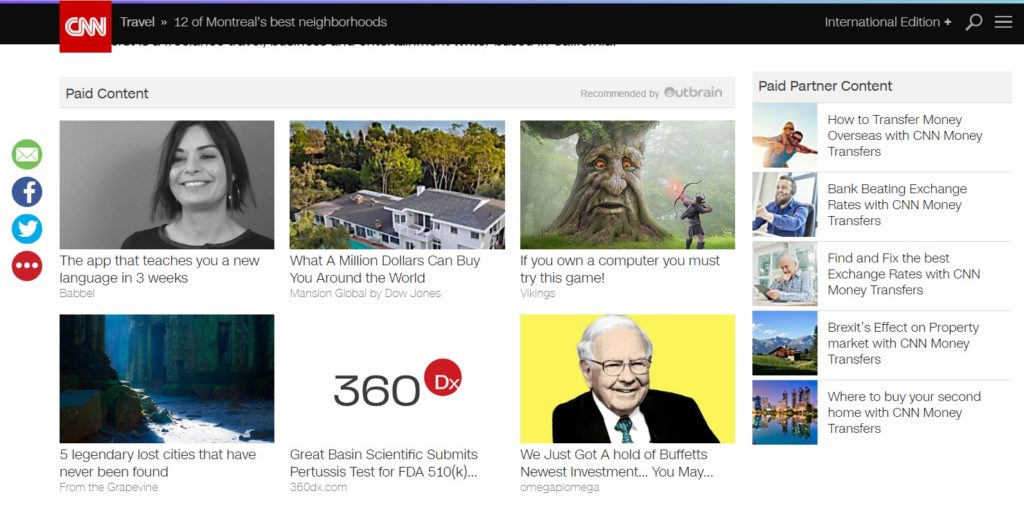
Advertising to children is increasingly prominent as more commercials are shown on TV. This raises the question of how advertising affects cognitive development. In addition to the potential psychological effects of advertisements, the study found that children do not know that athletes who appear in commercials are paid to promote certain products. Children are more susceptible to external influences than adults and are likely to be more affected by them. Educational Leadership's recent study found that children are unaware that athletes appearing in commercials promote products.
Empirical research
Advertising to children has long been viewed as having negative effects on their behavior. Although advertising may increase the desire to buy a product, its impact on children's behavior and attitudes goes far beyond just promoting its features. The evidence shows that children younger than seven are more likely to trust and interpret advertising claims. As a result, marketers have been making more effective use of this demographic to further their marketing and advertising goals.
A recent study examined advertisements for children. The researchers used a questionnaire and found that nearly half of those surveyed agreed that advertising helped children make informed consumer choices. However, advertising on children's television did not seem to affect young people's opinion of educational institutions. Advertising on children's TV might not have any negative effects on viewers young enough to be aware of it, but could have an impact on the perception of educational institutions.
Product disclosures

A child-inspired product announcement influenced children's perception of advertisements. It improved their ability to recognize advertising and recall product messages, while increasing their liking of brands. Pretest testing of brand recognition revealed that the child-inspired advertisement had a greater positive effect on brand attitudes and purchase intentions than its control counterpart. This finding has implications for the design of child-inspired product disclosures. Here are some ways advertisers can make product disclosures that are effective.
Advertisers must take care with what images they put on labels. This will ensure that children get the most useful product disclosures. Advertisers must include precise information about the product's intended usage. Often, written disclaimers might not suffice for child-friendly advertisements. While safety is important, parents need to make sure that product disclosures remain age-appropriate. Product packaging should not only contain child-friendly product information, but also have a simple and straightforward design.
Disclaimer
Disclaimers for advertising to children help advertisers explain potentially misleading statements in their advertisements. Advertisers have been required by the Federal Trade Commission (FTC) to disclose disclaimers using a dual-modality format. This format is more easily understood by young viewers. Researchers have analysed 3,800 TV commercials to find that child-rated programming has more emotional appeals, production techniques, and disclaimers in dual-modality formats. Future research should address these distractions in order to improve disclosures to kids.
Government-mandated disclaimers should also be subjected to the same level of evidence. This would not only improve the outcome for consumers, but would be more consistent with the First Amendment, which prohibits government from abridging the free speech of Americans. Advertising disclaimers must not be excluded from the First Amendment, which protects free speech of individuals as well as corporations. But if government is forced to use these disclaimers, the law may violate the First Amendment and make commercial advertising harmful.
Host-selling

If a cereal ad is featured in a TV show, this is known as host-selling to children. Dale Kunkel, psychologist showed that host-selling can reduce children's ability differentiate between advertisement and program content. Host-selling advertisements were more appealing to older children than they were to younger ones. Host-selling children can have many consequences, including the possibility of child abuse.
2004 was the year that host-selling was outlawed by FCC. The FCC also banned host-selling in 2004. It also required that licensees documented their compliance to the policy. It was delayed but it is now in effect for analog and DTV channels. Host-selling to children is a violation of FCC policy. FCC policy doesn't provide a clear definition for "host-selling." However bumpers are allowed to signal commercial breaks and program titles.
FAQ
How to Use Blogs to Generate Leads in Your Business
Online leads are crucial to B2B companies' success. Many businesses are struggling to convert traffic into qualified prospects despite knowing this. If you're wondering why this is happening, here are five possible reasons.
Reason 1: Your website isn't optimized. You don't make any money blogging! Blogging is a great way to attract new customers. Your blog posts should not solve problems for your target audience.
You can make sure your blog is profitable by optimizing it according to search engine guidelines. Also, ensure that it uses keywords people are searching. This increases the likelihood of people finding your blog post.
Once they find your blog post, ensure you provide value by answering their questions and providing solutions immediately.
Keyword Toolbox is a great tool for finding keywords. Then add those keywords to your page title, meta description and body text.
You should also include calls to action (CTAs) throughout your blog. CTAs encourage readers to take action, such as signing up for your newsletter, or purchasing a product.
These actions increase sales and give you insight as to what types of information users are most interested.
Check out our guide How to Start a Successful Blog.
Reason 2: You Don't Know What To Write About - Once You Begin Writing, You Will Find That The Ideas Come Quickly, But Then They Stop!
Building a reputation and establishing yourself as an expert within your niche takes time. To do this effectively, you must write about topics that interest your potential clients.
Your goal when writing is to answer the question, "why should I hire you?" Writing should be about solving problems.
This will help you stand out from other businesses that may just be trying to sell products.
Your blog should not only help your prospects but also be of benefit to them. Your expertise can be used to educate others. For example, you could talk about the latest trends in your industry or share tips for saving money on home improvement projects.
Provide links to other resources that will help your viewers learn more about these topics. These resources can be videos, articles, or podcasts that are written by experts.
Reason 3: You don't have any clients, and you don't want them - all you need is to make more sales now!
There is no quick way to build a successful company. It takes time to build trust with your target markets.
If you're not ready to build relationships with potential clients, however, you don’t have to spend hours writing content. Instead, place ads on social media websites like Facebook and LinkedIn.
Make sure your ads are targeted at the ideal client to save money and avoid ineffective advertising. A website design firm will most likely have many female clients.
Instead of targeting all males, you could target females by location, age group, income and many other criteria.
After creating your ad, you should follow-up by sending a message directly to your potential customers when you get a click through.
Don't forget that you don’t have to pay per person who visits the site. Some sources of traffic are more lucrative than others.
One example is hosting a contest for those who sign up via email. You can also give gifts to those who sign up for your mailing list.
This is where creativity is key. You don't have to spend too much to attract visitors.
Reason 4: It's not possible to afford advertising - your business is too busy running it, so you don't have the time.
You should always prioritize your work over your business. For instance, if you are too busy managing your business to market it, you will not be able to grow.
If you feel overwhelmed by the number of tasks you have to complete each day, you might not prioritize them correctly.
Start by organizing. One hour per week is enough to review and organize the tasks you need to complete during the week.
Once you begin, you'll be amazed at how much easier everything will be.
How can you create a content marketing strategy that is effective?
First, decide what type of content you want. This will help you create a content marketing plan that is effective. Next, you need to identify who your target market are and how they use Internet. Next, identify which channels best reach your target market. Finally, choose the right keywords for each channel and write compelling copy for each piece of content.
What are the content strategies for different topics?
Content strategy refers to all aspects that relate to how you create and manage digital content. Content strategy is not just about what you post to social media sites, such as Facebook or Twitter, but also the content you choose for your website, blog, or other online properties.
Content strategy is important because it defines how you decide where you focus your time and effort, which content types you should use, and what type of messages you send to your audiences.
It's all about understanding how content fits into your overall business goals and objectives in order to help achieve them.
What does Content Marketing look like?
A visitor to your site is searching for something in particular. Great if they find what they are looking for. If not, they will leave the site and look elsewhere. You can create helpful and relevant information that answers questions, solves issues, and adds value with content marketing. You can use this content across all platforms (social media, email, etc.) It will be available to everyone at all times.
Statistics
- Measure your goals with a progress indicator of 0-100%. Make your goals collaborative and transparent (semrush.com)
- An example of an overarching goal could be: "In 2022, we want to achieve a 20% increase in revenue created by organic content and generate 15,000 MQLs with a budget of $30,000." (semrush.com)
- Companies that use content marketing see approximately 30% higher growth rates than businesses not using it. (mailchimp.com)
- According to our research, 65% of companies with very successful content marketing in 2021 ran content audits at least twice a year. (semrush.com)
- We found that 40% of businesses don't have a documented strategy yet. (semrush.com)
- Content marketing produces 3X more leads per dollar spent. Content marketing costs 62% less than traditional marketing. (criteo.com)
- Out of the 1,500 marketers we surveyed for our State of Content Marketing report, 78% who felt their content marketing strategy was exceptionally effective in 2021 had documented their strategy. (semrush.com)
- According to our research, brand awareness, attracting traffic, and generating leads remain the key content marketing goals in 2022. (semrush.com)
External Links
How To
How to create beautiful images
Images are a great way to make your content standout from others. Images are one way to communicate ideas visually. They can grab attention and increase engagement. They help convey complex concepts simply and effectively, and they're also useful for highlighting key points in any kind of written content (e.g., blog posts, social media updates, etc. ).
Images can help to make a piece or presentation more interactive and lively if used correctly. However, if you don’t know what to do with the image you choose, your results could be less impressive. Here are some tips to help you choose the best images for your next job.
-
Know what makes an image good. Before you look at photos, there's a lot you need to know. First, make sure you choose clear and concise images. A cluttered photograph won't sell it. It won’t grab people's attention as well as a simple and clear one. You also want to avoid images where people aren't smiling or aren't looking directly into the camera. It can give the impression that what you're saying isn’t very interesting. It's important to make sure that the image doesn’t distract you from the main message. If it draws too much attention away from the content, then it's probably not ideal.
-
Look for inspiration. Once you have a list of possible candidates, it is time to look through them and select those that interest you. First, take a look at the captions. You will see that some photographers include them in the image, while others separate them. It doesn't matter what, you need to verify that the caption is engaging enough to read. Pay attention to the context. Do you expect to see someone having a good time in the photo? Maybe it seems dangerous. You might not associate it with happiness. Whatever the case, think about why you like the image and how it relates to the overall message you want to communicate.
-
Test different types of images. The best thing about using images in your content? They allow you to highlight certain parts of your text. You might want to include a picture of the product in action if you are writing about it. A similar image could be used to illustrate the information in an infographic. Visual aids such as these can help readers connect with your information.
-
Make sure you use the correct file format. You must remember which file format you should use when choosing images. You have two choices when creating web pages: JPEG, or GIF. Both are great file formats, but each has its pros and cons. JPEG files are suitable for any sort of media, including websites and social media posts. They work particularly well for photos, as they store large amounts of data in a small space. They can lose their quality over time and become pixelated after a while. GIFs are smaller and more suitable for animation and graphics than JPEGs. GIFs don't allow transparency which makes them unsuitable for photo editing.
-
Add other visuals. Additional visuals are a great idea if you have trouble thinking of images. This can help you make your post more effective by creating a distraction-free atmosphere for your readers. They are less likely to leave the page when they read your article. Infographics are a great way to add visuals to your website. Infographics are a popular way to quickly share lots of information. They are also great for adding visuals to your blog posts.